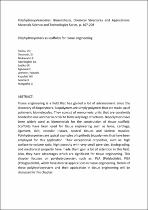JavaScript is disabled for your browser. Some features of this site may not work without it.
- ResearchSpace
- →
- Research Publications/Outputs
- →
- Book Chapters
- →
- View Item
| dc.contributor.author |
Fasiku, VO

|
|
| dc.contributor.author |
Owonubi, SJ

|
|
| dc.contributor.author |
Mukwevho, E

|
|
| dc.contributor.author |
Aderibigber, BA

|
|
| dc.contributor.author |
Sadiku, ER

|
|
| dc.contributor.author |
Agboola, O

|
|
| dc.contributor.author |
Lemmer, Yolandy

|
|
| dc.contributor.author |
Kupolati, WK

|
|
| dc.contributor.author |
Selatile, K

|
|
| dc.contributor.author |
Makgatho, G

|
|
| dc.date.accessioned | 2018-10-15T11:10:17Z | |
| dc.date.available | 2018-10-15T11:10:17Z | |
| dc.date.issued | 2018-05 | |
| dc.identifier.citation | Fasiku, V.O. et al. 2018. Polyhydroxyesters as scaffolds for tissue engineering. Polyhydroxyalkanoates: Biosynthesis, Chemical Structures and Applications: Materials Science and Technologies Series, pp. 167-208 | en_US |
| dc.identifier.isbn | 978-1-53613-439-1 | |
| dc.identifier.isbn | 1536134392 | |
| dc.identifier.uri | https://bit.ly/2OoDL85 | |
| dc.identifier.uri | https://novapublishers.com/shop/polyhydroxyalkanoates-biosynthesis-chemical-structures-and-applications/ | |
| dc.identifier.uri | http://hdl.handle.net/10204/10462 | |
| dc.description | Copyright: 2018 Nova Publishers. Due to copyright restrictions, the attached PDF file only contains the abstract of the full text item. For access to the full text item, please consult the publisher's website. | en_US |
| dc.description.abstract | Tissue engineering is a field that has gained a lot of advancement since the discovery of biopolymers. Biopolymers are simply polymers that are made-up of polymeric biomolecules. They consist of monomeric units that are covalently bonded to one another in order to form very large structures. Biopolymers have been widely used as biomaterials for the construction of tissue scaffold. Scaffolds have been used for tissue engineering such as bone, cartilage, ligament, skin, vascular tissues, neutral tissues and skeletal muscles. Polyhydroxyesters are typical examples of synthetic biopolymers that have been employed for this application. Their exceptional properties, such as: high surface-to-volume ratio, high porosity with very small pore size, biodegrading, and mechanical property have made them gain a lot of attention in this field. Also, they have advantages which are significant for tissue engineering. This chapter focuses on polyhydroxeester, such as: PLA (Polylactide), PGA (Polyglycolide0, which have diverse applications in tissue engineering. Details of these polyhydroxyesters and their application in tissue engineering will be discussed in this chapter. | en_US |
| dc.language.iso | en | en_US |
| dc.publisher | Nova Science Publishers | en_US |
| dc.relation.ispartofseries | Worklist;21390 | |
| dc.subject | Biopolymer | en_US |
| dc.subject | Polyhydroxyesters | en_US |
| dc.subject | Scaffold | en_US |
| dc.subject | Tissue engineering | en_US |
| dc.title | Polyhydroxyesters as scaffolds for tissue engineering | en_US |
| dc.type | Book Chapter | en_US |
| dc.identifier.apacitation | Fasiku, V., Owonubi, S., Mukwevho, E., Aderibigber, B., Sadiku, E., Agboola, O., ... Makgatho, G. (2018). Polyhydroxyesters as scaffolds for tissue engineering., <i>Worklist;21390</i> Nova Science Publishers. http://hdl.handle.net/10204/10462 | en_ZA |
| dc.identifier.chicagocitation | Fasiku, VO, SJ Owonubi, E Mukwevho, BA Aderibigber, ER Sadiku, O Agboola, Yolandy Lemmer, WK Kupolati, K Selatile, and G Makgatho. "Polyhydroxyesters as scaffolds for tissue engineering" In <i>WORKLIST;21390</i>, n.p.: Nova Science Publishers. 2018. http://hdl.handle.net/10204/10462. | en_ZA |
| dc.identifier.vancouvercitation | Fasiku V, Owonubi S, Mukwevho E, Aderibigber B, Sadiku E, Agboola O, et al. Polyhydroxyesters as scaffolds for tissue engineering.. Worklist;21390. [place unknown]: Nova Science Publishers; 2018. [cited yyyy month dd]. http://hdl.handle.net/10204/10462. | en_ZA |
| dc.identifier.ris | TY - Book Chapter AU - Fasiku, VO AU - Owonubi, SJ AU - Mukwevho, E AU - Aderibigber, BA AU - Sadiku, ER AU - Agboola, O AU - Lemmer, Yolandy AU - Kupolati, WK AU - Selatile, K AU - Makgatho, G AB - Tissue engineering is a field that has gained a lot of advancement since the discovery of biopolymers. Biopolymers are simply polymers that are made-up of polymeric biomolecules. They consist of monomeric units that are covalently bonded to one another in order to form very large structures. Biopolymers have been widely used as biomaterials for the construction of tissue scaffold. Scaffolds have been used for tissue engineering such as bone, cartilage, ligament, skin, vascular tissues, neutral tissues and skeletal muscles. Polyhydroxyesters are typical examples of synthetic biopolymers that have been employed for this application. Their exceptional properties, such as: high surface-to-volume ratio, high porosity with very small pore size, biodegrading, and mechanical property have made them gain a lot of attention in this field. Also, they have advantages which are significant for tissue engineering. This chapter focuses on polyhydroxeester, such as: PLA (Polylactide), PGA (Polyglycolide0, which have diverse applications in tissue engineering. Details of these polyhydroxyesters and their application in tissue engineering will be discussed in this chapter. DA - 2018-05 DB - ResearchSpace DP - CSIR KW - Biopolymer KW - Polyhydroxyesters KW - Scaffold KW - Tissue engineering LK - https://researchspace.csir.co.za PY - 2018 SM - 978-1-53613-439-1 SM - 1536134392 T1 - Polyhydroxyesters as scaffolds for tissue engineering TI - Polyhydroxyesters as scaffolds for tissue engineering UR - http://hdl.handle.net/10204/10462 ER - | en_ZA |






